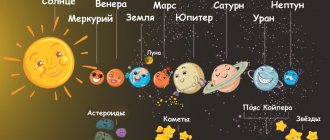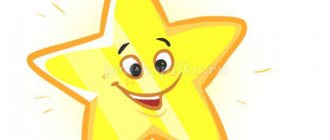Astronomy for children > Solar system > Planet Earth
Everything about planet Earth for children: how it appeared and was formed, interesting facts, what the structure is made of in photos and drawings, the rotation of the Earth, the Moon and life.
start a story about Earth for the little ones with the fact that we live on the third planet from the Sun. Parents or teachers at school had to explain to the children that they were very lucky. After all, the Earth is so far the only known planet in the solar system that contains an atmosphere with oxygen, liquid oceans on the surface and life.
If we consider by size, then we occupy fifth place (less than Jupiter , Saturn , Uranus and Neptune , but more than Mercury and Venus ).
The diameter of planet Earth is 13,000 km. It is circular in shape because gravity pulls in matter. Although this is not a perfect circle, because rotation causes the planet to compress at the poles and expand at the equator.
Water occupies approximately 71% (most of it is oceans). 1/5 of the atmosphere consists of oxygen, which is produced by plants. While scientists have been studying the planet for centuries, spacecraft have made it possible to look at it from space. Below, schoolchildren and children of all ages will be able to consider interesting facts about the Earth and receive a full description of the third planet from the Sun with photos and pictures. But it should be recalled that the Earth has a class, or rather a planetary type - a rocky body (there are also ice and gas giants that differ in characteristics).
Characteristics of the Earth's orbit - explanation for children
To give a complete explanation for children , parents must unpack the concept of axis. This is an imaginary line running through the center from the North to the South Pole. It takes 23.934 hours to complete one revolution, and 365.26 days (Earth year) to orbit around the Sun.
The tilt of the earth's axis and the movement of the planet throughout the year
Children should know that the Earth's axis is tilted relative to the plane of the ecliptic (the imaginary surface of the Earth's orbit around the Sun). Because of this, the northern and southern hemispheres sometimes rotate and face away from the Sun. This leads to a change in seasons (the amount of light and heat received changes).
The Earth's orbit is not a perfect circle, but an oval ellipse (this is common to all planets). It approaches the Sun in early January and moves away in July (although this has less effect on heating and cooling than the tilt of the Earth's axis). should be explained to children . This is the distance that allows the temperature to maintain water in a liquid state.
BOOK FOR CHILDREN “Tales of Mother Earth” page 1 of 2
(for preschool and primary school age)
The book shows the beauty of our native land, fosters a love of nature and a sense of responsibility for the world around us. The book contains 250 fairy tales and poems that will bring children’s consciousness closer to nature and teach them to care for it; lyrical poems that deeply reveal the wonder of nature to children; creative tasks and games that develop in children a sense of the relationship between nature and man. In the book you will find legends and fairy tales on the topics:
|
The formation and evolution of the Earth - an explanation for children
The explanation for children will remain incomplete if the description of the Earth bypasses prehistory. Researchers believe that the Earth formed along with the Sun and other planets 4.6 billion years ago. Then the Solar system was reunited with a huge gas and dust cloud - the solar nebula. Gravity gradually destroyed it, giving it more speed and a disk shape. Much of the material was drawn to the center and began to form the Sun.
Other particles collided and combined to form larger bodies. The solar wind was so powerful that it managed to dislodge lighter elements (hydrogen and helium) from the most distant worlds. This is why the Earth and other planets became rocky.
In early history, planet Earth may seem like a lifeless piece of rock to children. Radioactive materials and pressure rising from the depths provided enough heat to melt the interior. This caused some chemicals to splash out to form water, while others became atmospheric gases. According to recent data, the crust and oceans could have appeared 200 million years after the formation of the planet.
Children should know that earthly history is divided into 4 eons: Hadean, Archean, Proterozoic and Phanerozoic. The first three took almost 4 billion years and are collectively called the Precambrian. Evidence of life was discovered in the Archean about 3.8 billion years ago. But life was not rich until the Phanerozoic.
The Phanerozoic period is divided into 3 eras: Paleozoic, Mesozoic and Cenozoic. The first demonstrated the emergence of many varieties of animals and plants in the seas and on land. The Mesozoic provided dinosaurs, but the Cenozoic is literally our era (mammals).
Hypothetical view of the planet 3 billion years ago
Most fossils from the Paleozoic are invertebrate animals (corals, trilobites and mollusks). Fish fossils have been dated back to 450 million years ago, and amphibians to 380 million years old. Vast forests, swamps and early reptiles inhabited the Earth 300 million years ago.
The Mesozoic was the period in which dinosaurs lived. Although mammal fossils were also 200 million years old. During this period, flowering plants seized power (and continue to do so today).
The Cenozoic era began about 65 million years ago, when the dinosaurs became extinct (scientists attribute this to cosmic influences). Mammals managed to survive, and they became the main creatures on the planet.
Tale about Yaroslav “Space travel - planet Earth”
Hello! My name is Yaroslava! I appeared in your world quite recently. At first, I lived in my mother’s tummy for 9 months. Of course, I haven’t been there very often. So, I flew there sometimes to get used to my new clothes, my new body. And then I flew to my planet, into the “distances of space,” as you say.
In fact, life on Earth is a great space adventure for us! We are actually space travelers across all Universes, flying through different galaxies, hitchhiking and doing various important cosmopolitan matters. Of course, no one will be born “anywhere” just for fun. First you need to show all your skills and abilities, your stellar achievements. Tell us what you can do well, what positive things you have done in this or that point in outer space.
With the Earth, of course, everything is simpler now. There has been an active recruitment of volunteers here for many space years. This is a hot zone! It should be noted that it is very interesting here, but not everyone will be able to fly here. You need to have a lot of special data in your application form to be accepted.
Until recently, there was an active need for such special volunteers as dismantlers, transformers, connectors, restorers and similar workers. And now our time has come, construction specialists. Now we are recruiting architects and builders, creators and creators of all aspects of life.





